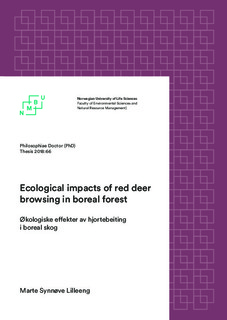| dc.description.abstract | The populations of wild ungulates are increasing in the northern hemisphere, and in many areas, their populations have developed from critically low to historically high numbers within the last century. There are multiple causes for this increase, which differ between species and areas. In general, however, changing forestry techniques, reduced free-ranging livestock herbivory, and milder climate have increased food plant availability and thereby stimulated the wild ungulate population growth. This, in combination with hunting regulations that favor increased productivity and the reduction or removal of large predators, has been central for the ungulate population growth. Because large herbivores affect their ecosystems via various mechanisms in such as selective feeding on plants, trampling, defecation, and urination, they are considered as potential ecosystem engineers. Hence, the dramatic increase in population densities has become an ecological concern. Populations without substantial natural predation may risk to reach overabundance. Wild ungulates may, however, already have severe impacts on their ecosystem long before reaching overabundance. Knowledge about the ecological role of how different ungulate densities can shape and impact their ecosystems, is therefore central for determining appropriate population management goals, and to prevent irreversible effects on the ecosystem.
In Scandinavia, cervids were relatively rare around 1900. In recent decades, the populations have shown an exponential increase in population size. In Norway, the red deer (Cervus elaphus) population has increased approximately 150-fold since 1900, and passed the moose (Alces alces) as the most hunted ungulate around 2010. This development has been applauded by hunters, but creates concern among foresters and nature management authorities, regarding forest regeneration, loss of biodiversity, and potential trophic cascades. However, many aspects of how variation in red deer population densities can affect ecological dynamics in the boreal forest remain unclear.
The main objective of this thesis was to identify how red deer, and variation in their densities, may structure the boreal forest and affect dynamics, composition and diversity of ecological communities. I investigated how historically high densities of red deer affect the understory plant and insect communities. Such changes can alter food and habitat availability for, for example, forest dwelling birds and mammals, and implies that red deer may induce trophic cascades. I used a long-term, paired exclosure vs. deer-access research design to reach my objectives. The exclosures were established in December 2000 within old-growth pine-bilberry (Pinus sylvestris-Vaccinium myrtillus) forest at the Svanøy island in Western Norway, as part of a long-term research project to assess how red deer affect ecological dynamics in general (the EcoDynDeer project). Specifically, I investigated the role of red deer browsing on the structure, abundance, and diversity of plant (paper I and II) and insect communities (III). In addition, I studied whether red deer may induce trophic cascades by modifying interactions between the key boreal plant, bilberry, and the ecological important insect group of herbivorous Lepidoptera and Symphyta (paper IV).
We found that intermediate red deer browsing intensities resulted in the most species rich understory plant communities (Paper I). We found that growth-form determined much of the plants responses to browsing. In general, early succession and prostrate growing species benefited (Paper I), whereas there was a reduction of woody species when exposed to red deer browsing (Paper I & II). This dichotomy between growth forms was reflected in a positive relationship between temporal heterogeneity and red deer browsing, as higher plant species turnover rates occurred at higher browsing intensities (Paper II). Red deer browsing had a homogenizing effect on the spatial distribution of plant species, and thus made the plant communities more similar across sites than would be expected based on the variation in abiotic factors (Paper II).
The ground-dwelling beetle community responded differently to red deer browsing compared to plants. The overall beetle species richness did not relate to red deer browsing (Paper III). Although, as for the plants, measured in abundance, there were more beetle species benefitting from red deer browsing than those that decreased (Paper III). The species in disadvantage of browsing were functionally related to plant cover and detritus or arthropod predation (Paper III). Red deer browsing structured the ground-dwelling beetle community. Contrary to the effect on the plant community, red deer browsing increased the ground-dwelling beetle heterogeneity (beta diversity, Paper III). Thus the beetle assemblages showed higher local variation between plots where red deer had access than in exclosures. Finally, we showed that red deer also affected other primary consumers. The abundance of herbivorous larvae was halved by red deer browsing (Paper IV). The main mechanism behind this response appeared to be the removal of biomass (Paper IV). Interestingly, our results also indicated that red deer browsing alters the nutritional quality of shared food plants (Paper IV). The larvae selected the highly browsed bilberry ramets much stronger than ramets subjected to both lower, and extremely heavy, browsing intensity. The reductions in larvae numbers are likely to affect forest vegetation-dwelling bird species of which their reproductive success depends on insect larvae densities. Hence, our results suggest that red deer has the potential for inducing trophic cascades. | nb_NO |

